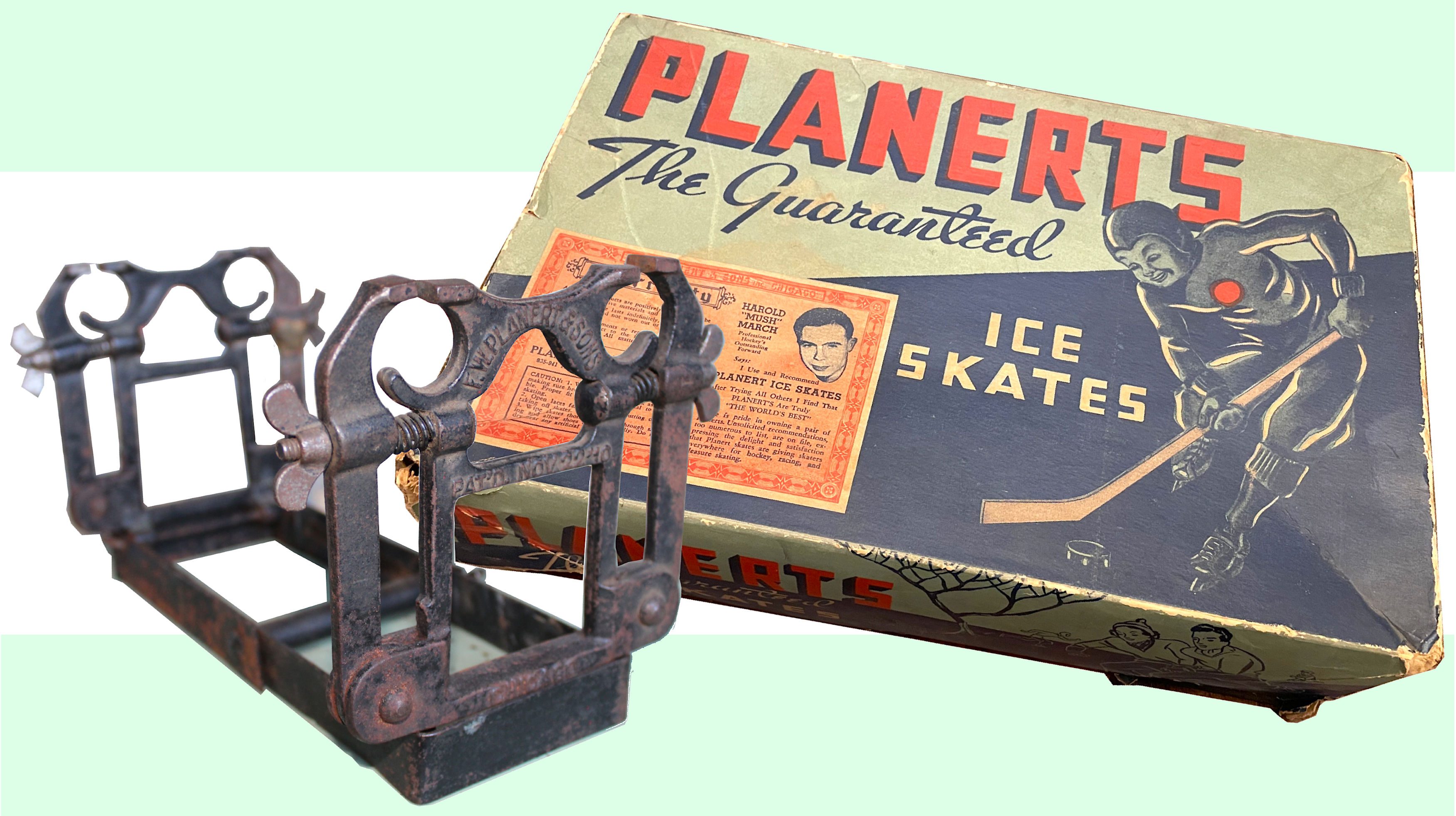
Museum Artifact: Planert Ice Skate Sharpening Jig (1910s) and Ice Skate Box (1930s)
Made By: F.W. Planert & Sons, Inc., 935-941 N Damen Ave., Chicago, IL [East Ukrainian Village]
“Perfect design—perfect alignment—perfect fit and perfect performance. The New Planert All Steel—Full Tubular Skates are now the most popular of all skates. Their beautiful stream lines—their perfect fitting fine leather shoes and wonderful quality steel construction has won the hearts of every boy and girl who appreciates speed, lightness and extra years of service.” –Planert Ice Skate advertisement, 1927
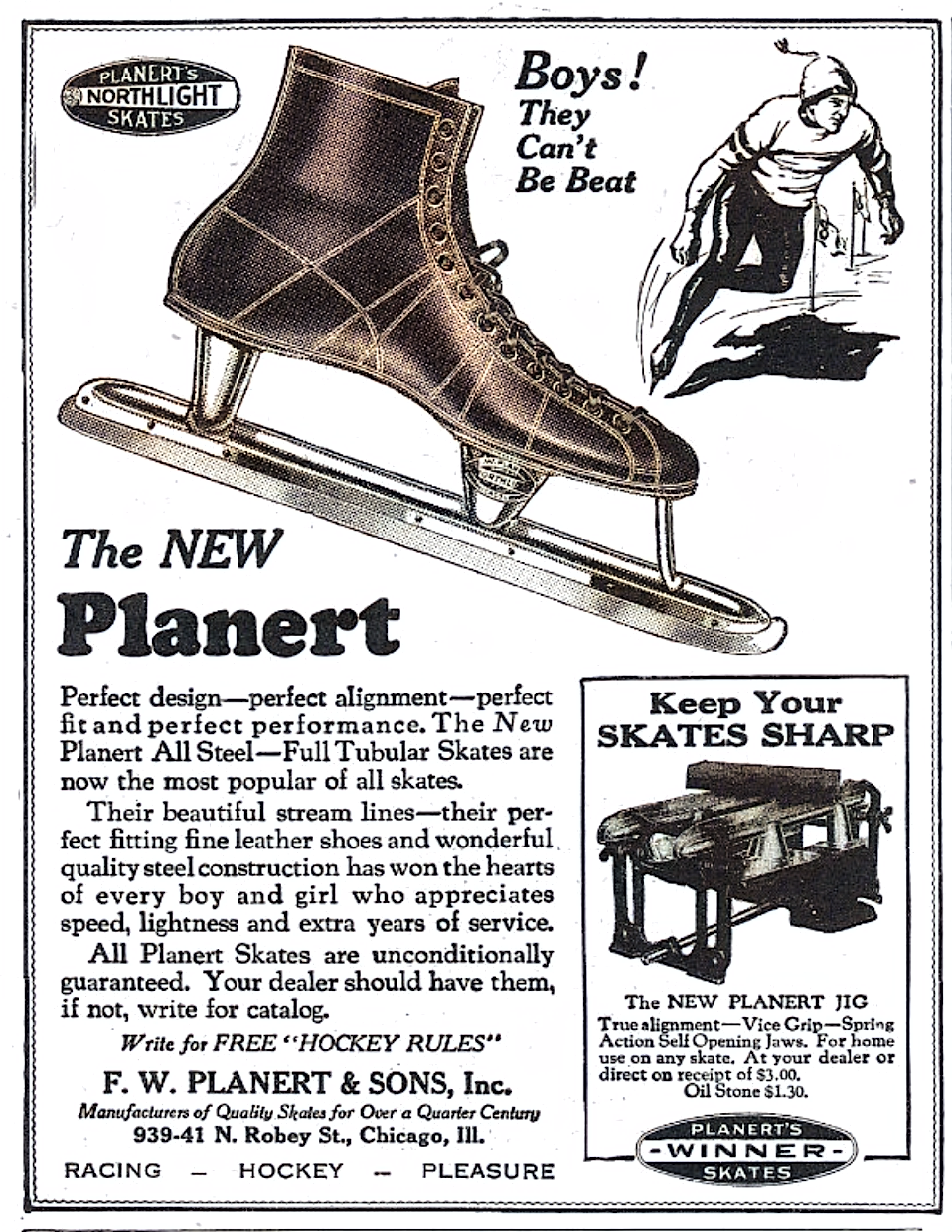 F.W. Planert & Sons, aka the Planert Skate Company, was one of the “The Big 3” in the Chicago-dominated ice skate industry of the early 20th century. The other two notable names, family rivals Nestor Johnson and Alfred Johnson, were also headquartered on the Northwest side. I suppose we should probably count the sporting goods giant A.G. Spalding & Bros. as a major player in the business, too, considering their far wider reach and Chicago roots. But where Spalding made basically every type of sports gear under the sun, Planert and the two Johnson Co’s were more focused on hardcore, dyed-in-the-wool ice rink culture.
F.W. Planert & Sons, aka the Planert Skate Company, was one of the “The Big 3” in the Chicago-dominated ice skate industry of the early 20th century. The other two notable names, family rivals Nestor Johnson and Alfred Johnson, were also headquartered on the Northwest side. I suppose we should probably count the sporting goods giant A.G. Spalding & Bros. as a major player in the business, too, considering their far wider reach and Chicago roots. But where Spalding made basically every type of sports gear under the sun, Planert and the two Johnson Co’s were more focused on hardcore, dyed-in-the-wool ice rink culture.
As you can see from the artifacts in our museum collection, this wasn’t necessarily limited to the skates themselves. The rather fearsome looking metal clamping device pictured above was known as a sharpening stand or a “jig,” and served the purpose of holding a skate secure in an upside down position so its owner could attack the blades with a hand-held sharpening tool.
The particular model of Planert skate sharpening stand in our collection has a patent date of 1910, tying it to a design by Henry C. and Edward J. Knudsen of Cleveland, Ohio. Later updates of the same concept, including a 1933 patent belonging to George R. Planert, looked a little bit less like a medieval torture device. The price tag for that model was usually around $3.00 (roughly 50 bucks after inflation), with catalog blurbs describing it as a “quick positive jig for sharpening tubular racing and hockey skates. No trouble experienced in lining up the blades. Four vise-like jaws grip the blade parallel and perpendicular. Adjustable folding base fits any size skate.”
Skate holders and sharpeners have continued to evolve over the ensuing 100 years, rendering these old finger-pinching contraptions obsolete, aside from their notable repurposing potential as fancy bookends.
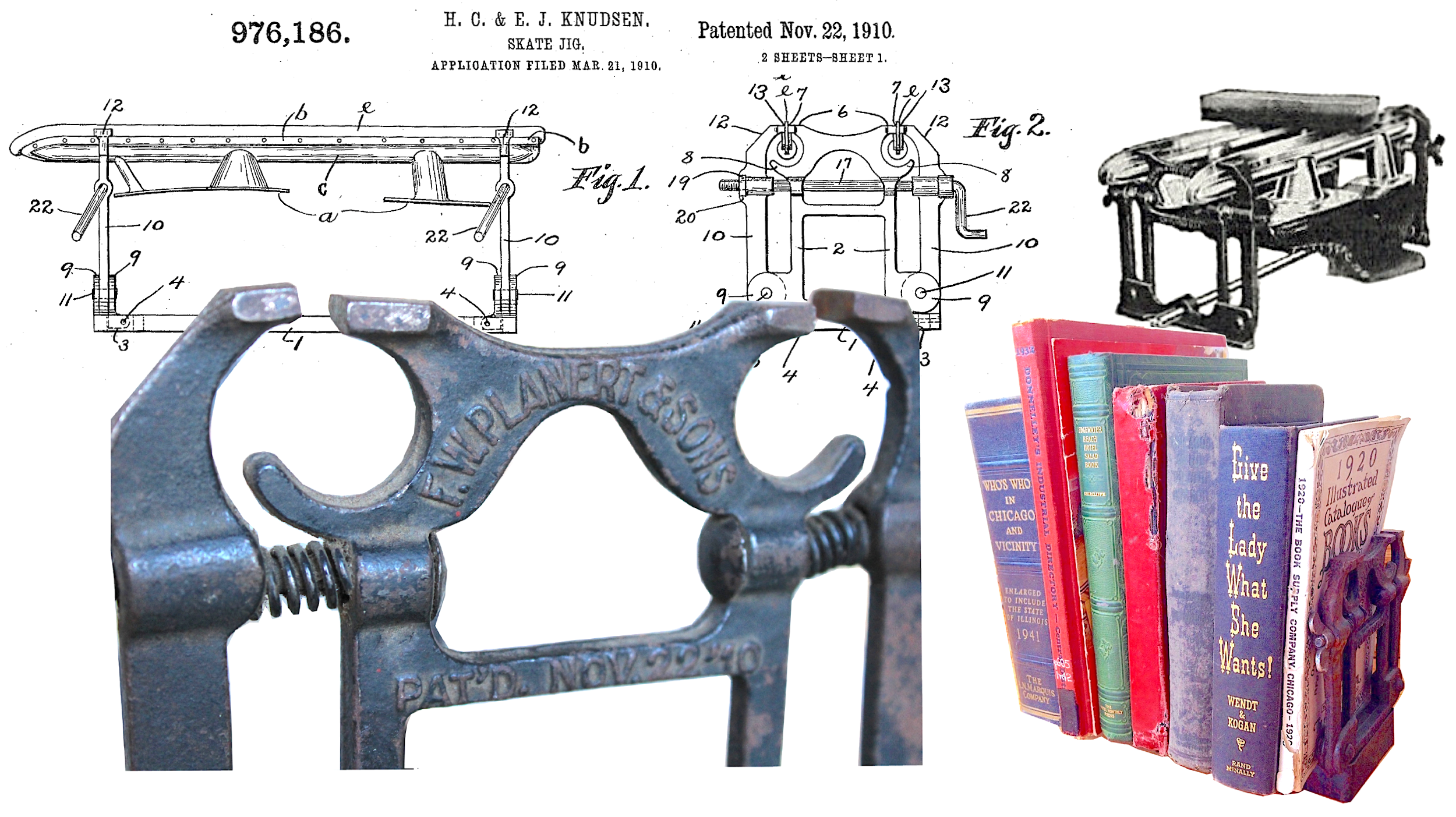
[The Planert skate jig in our museum collection features a design patented in 1910 by H.C. and E.J. Knudsen. George Planert later adapted a version of his own, patented in 1933. Today, the old 1910 jig makes for an amusing book holder.]
The other featured item in our collection is a snazzy green box from which a pair of shiny new Planert hockey skates would have emerged, circa 1935. The box, which was discovered (sadly separated from its former contents) at the Mercantile M antique shop in Andersonville, is relatively easy to carbon-date thanks to the Warranty badge on its cover, which prominently features Chicago Blackhawks hockey legend Harold “Mush” March—“Professional Hockey’s Outstanding Forward.”
The Canadian-born March, who played his entire 17-year NHL career with Chicago from 1928-1945, was a 5-foot-5, 150 LB sparkplug who helped lead the Hawks to Stanley Cup titles in 1934 and 1938. And so, as a local hero and nationally recognized star of the ice, March made an excellent pitchman for the Planert brand.
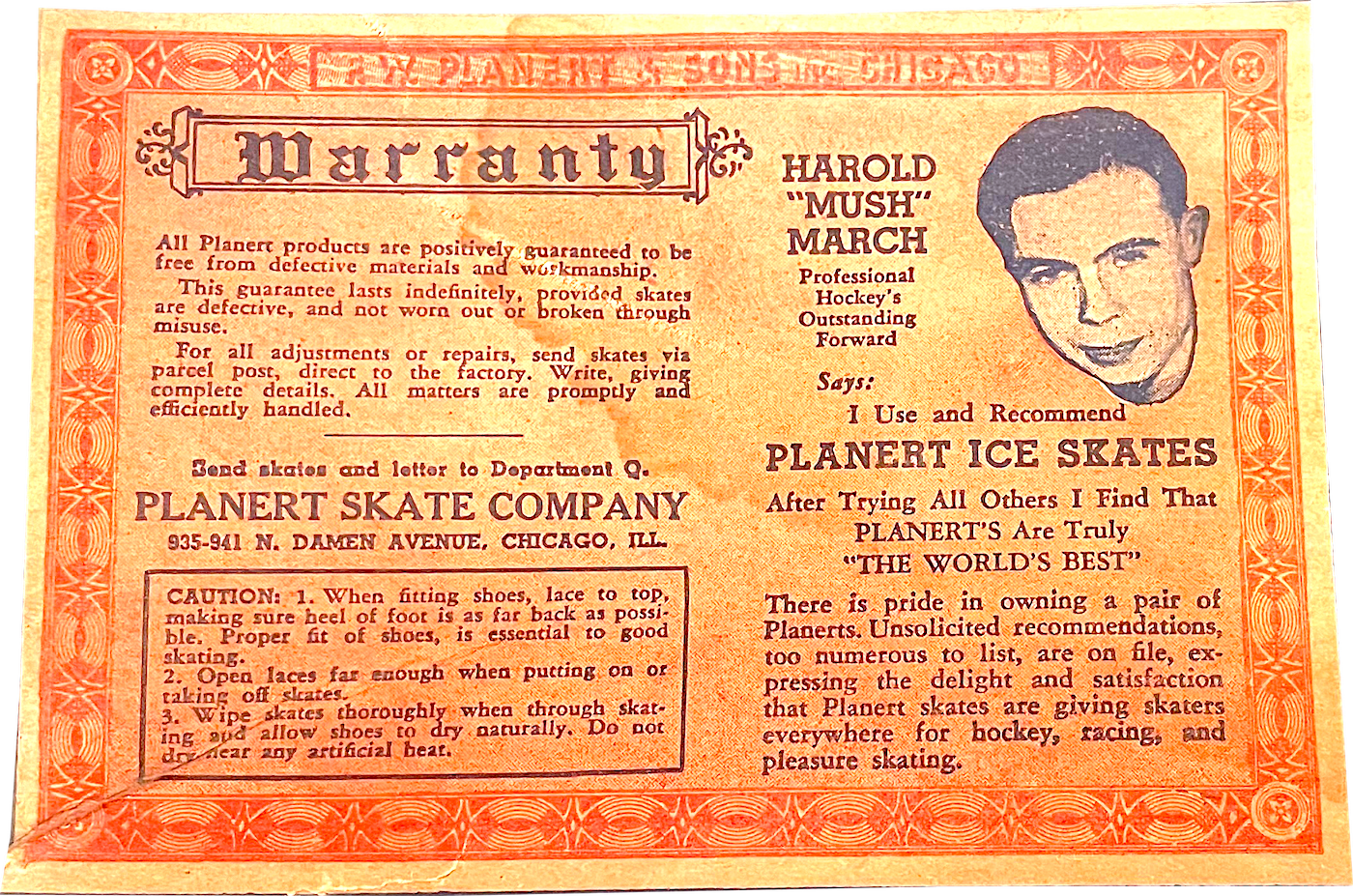
“I use and recommend Planert Ice Skates,” March is quoted right there on the box. “After trying all others I find that Planert’s truly are the World’s Best.”
Believe it or not, Mush’s praise was probably an early example of a paid athlete endorsement, rather than his own genuine assessment of the product (gasp!). And indeed, the Blackhawks’ devotion to the Planert brand, or vice versa, proved less than steadfast as the Depression wore on. Despite their fruitful affiliation during the championship season of 1934, the sponsorship deal ended shortly thereafter, and rival skate-makers Nestor Johnson swooped and grabbed the Hawks outfitting deal by the time the club hoisted Lord Stanley’s Cup again in ’38.
As for Mush March, he hasn’t been enshrined in the Hockey Hall of Fame just yet, but he is honored in the equally visitable Saskatchewan Sports Hall of Fame. And like F. W. Planert himself, he’ll always hold a special place in Chicago sporting lore—a legacy no zamboni could ever smooth over.
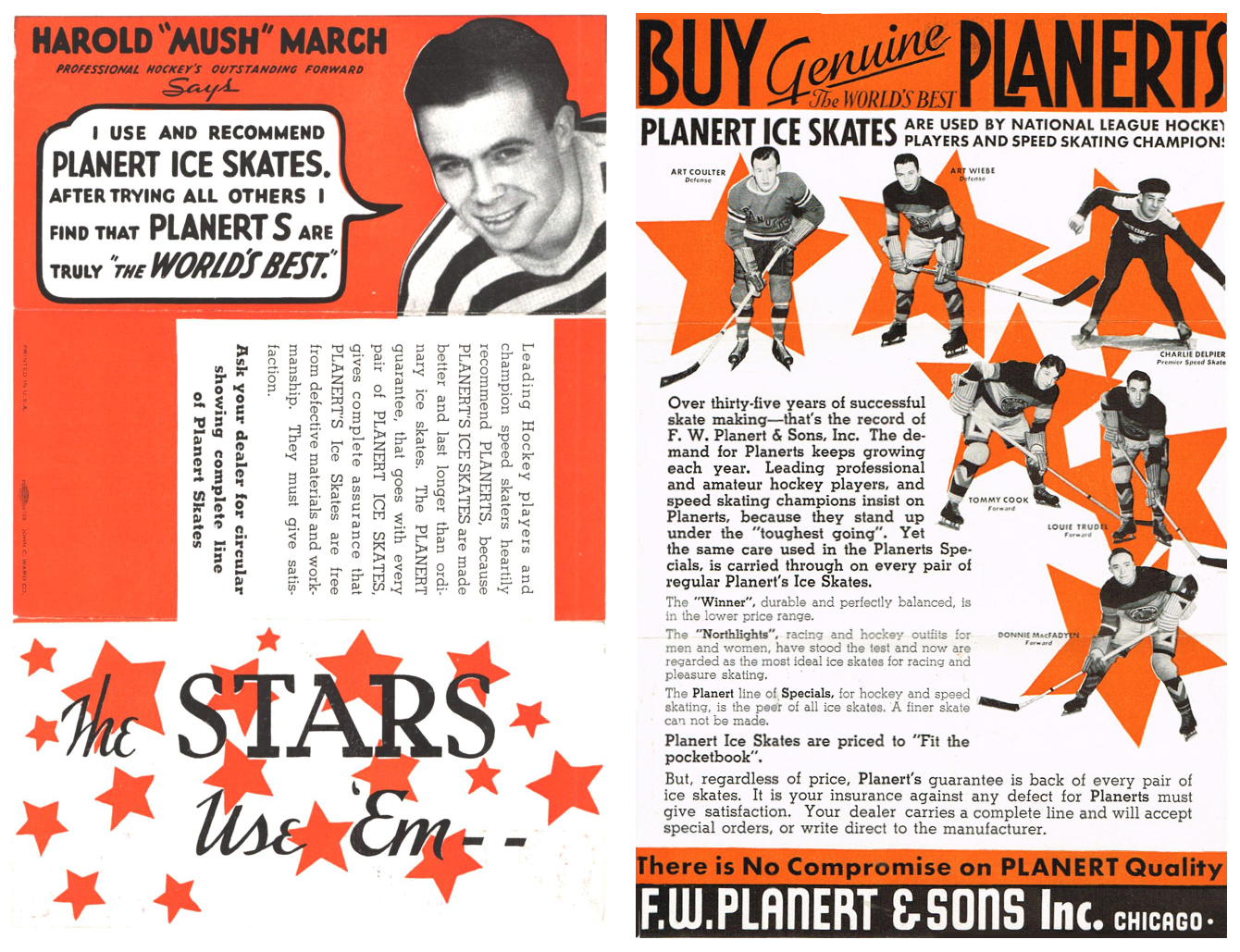
[Promotional ads of the mid 1930s, showcasing Planert’s affiliation with the Chicago Blackhawks, including stars Mush March, Art Coulter, Tommy Cook, and Louie Trudel]
History of Planert Skates, Part I: Skate Said Fred
Ferdinand “Fred” Planert was born in Leipzig, Germany, in 1857, and came to the States as a teenager in 1873—bringing with him the precision engineering skills and winter sports prowess of his native land. For a solid 20 years, he worked as a machinist, making a humble living to support his wife Anna and their five children. As the story goes, it wasn’t until around 1898, when Fred was already in his 40s, that a request from one of his sons started him off on a new life’s calling.
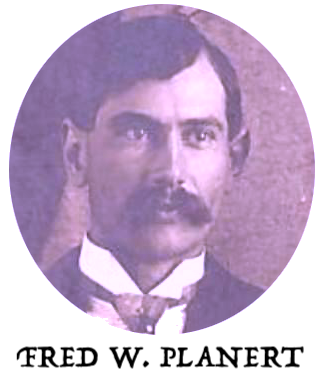 A small boy wanted a pair of racing skates,” according to a 1926 article in Hardware Dealers Magazine, recalling the roots of Planert & Sons. “This boy’s father was F. W. Planert and, being a mechanic, he measured to what his son expected of him. This job won for Mr. Planert the enviable reputation of being the pioneer manufacturer of high grade tubular skates.”
A small boy wanted a pair of racing skates,” according to a 1926 article in Hardware Dealers Magazine, recalling the roots of Planert & Sons. “This boy’s father was F. W. Planert and, being a mechanic, he measured to what his son expected of him. This job won for Mr. Planert the enviable reputation of being the pioneer manufacturer of high grade tubular skates.”
In reality, it remains highly debatable whether Planert could lay exclusive claim to the innovation of the all-in-one “tube skate,” in which the blade is connected securely to the boot via an internal aluminum tube. Fact is, while Fred may well have built a prototype for his son as early as 1898, the well established Starr MFG Company of Canada made a far bigger impact with its first “Silver King” tube skates in 1900. Chicago rival Nestor Johnson, as well, collected a patent for his tubular skate design in 1904, more than five years before the first mentions of F. W. Planert & Sons and their “Northlight” brand begin to appear in local newspapers.
We’re not sure exactly how the German-born Planert and Norwegian-born Johnson felt about one another, but it’s safe to say they brushed shoulders plenty in the Chicago skate scene. In 1913, for example, Planert & Sons sponsored a well attended speed skating competition in Douglas Park, in which the winner was awarded the “Planert Cup” trophy. Not to be outdone, Nestor Johnson was also working the event that day . . . as an official.
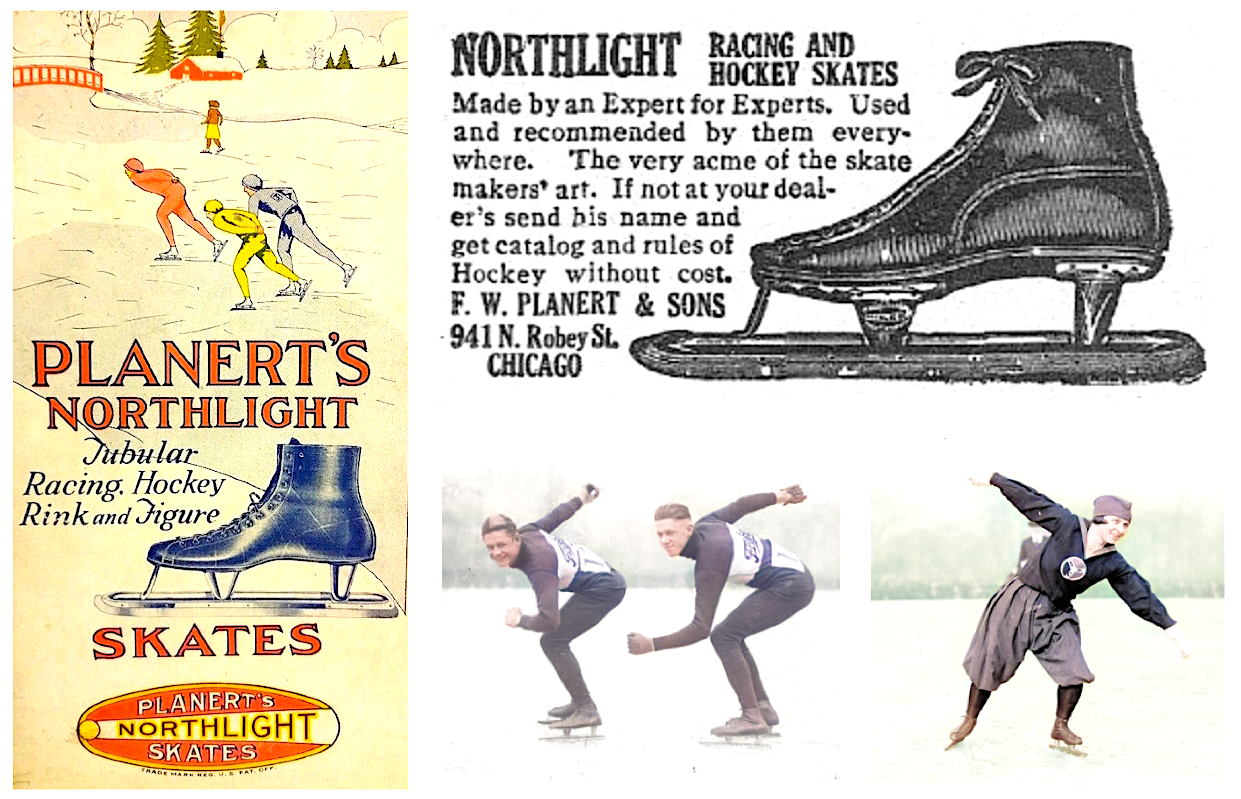
[Early advertisements for Planert’s “Northlight” skates, 1915-1920. Also pictured are the Steinmetz brothers and Rose Johnson, ice skaters in Chicago, 1918.]
It was no accident that the ice skate industry had become unofficially headquartered in Chicago. The city boasted more than 600 outdoor ice rinks by 1923—most in the country according to the Encyclopedia of Chicago—and major skating competitions like the “Silver Skates” races in Humboldt Park regularly drew over 50,000 spectators. This was partly thanks to the city’s large population of Germans, Swedes, Ukrainians, and other immigrant communities with multi-generational ties to skating in all its various forms. That said, the skate craze was hardly limited to any specific demographic. Planert’s products, to risk a devastatingly bad pun, had true planertary appeal.
Whether viewed as the innovator or the also-ran in the tubular skate revolution, the quality of Planert’s product became self evident over time, and the company’s factory space at 939 N. Robey Street (located nextdoor to the Planert family home) soon shifted into high gear, producing a mix of hockey skates, speed skates, leisure skates, and the precious footwear of ice ballerinas.
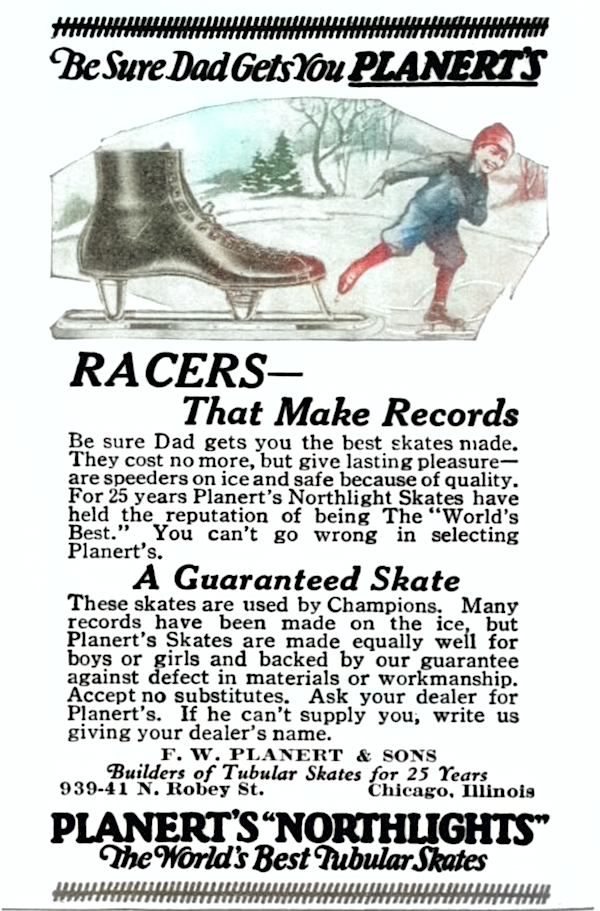 After World War I, with anti-German sentiments gradually assuaging, the Planert advertising budget increased considerably on the national scale, with eye catching promos in Popular Mechanics, the Saturday Evening Post, and Boy’s Life, among others. These ads usually focused on skates for kids, but the simultaneous goal was to make an impression on those kids’ parents; the ones actually tasked with choosing which brand to buy. To this audience, quality and safety meant more than speed and style. So, while an advertisement might start out talking about stocking stuffers—“What greater gift for the kiddies than the Joy of Perfect Skating?”—they always eventually came around to describing the product more like a fine German automobile, using the dull but effective slogan: “The World’s Best.”
After World War I, with anti-German sentiments gradually assuaging, the Planert advertising budget increased considerably on the national scale, with eye catching promos in Popular Mechanics, the Saturday Evening Post, and Boy’s Life, among others. These ads usually focused on skates for kids, but the simultaneous goal was to make an impression on those kids’ parents; the ones actually tasked with choosing which brand to buy. To this audience, quality and safety meant more than speed and style. So, while an advertisement might start out talking about stocking stuffers—“What greater gift for the kiddies than the Joy of Perfect Skating?”—they always eventually came around to describing the product more like a fine German automobile, using the dull but effective slogan: “The World’s Best.”
“The high quality and sturdy construction maintained for over 25 years, makes Planert Skates the public’s first choice,” read one 1925 magazine ad. “Champions also prefer them. . . . You will at once recognize Planert Superiority—by the high quality steel runner, so tempered that sharpening is seldom necessary—by the cups, drawn of one piece steel, seamless and flanged over tube—by the custom-made shoes of fine quality leather giving solid foot comfort—the wide tongue which prevents pinching.”
“They are built for lightness and speed,” read another ad, “but their excellent quality and sturdy construction means safety as well.”
Even amid stiff competition from the Nestor and Alfred Johnsons of the world, F.W. Planert & Sons nonetheless established its own unique street cred, or “ice cred,” among enthusiasts. As the firm’s workforce grew to meet higher demand, though, Fred Planert didn’t seem interested in seeking out a new, larger headquarters. Instead, the original Robey Street assembly plant would remain in use for decades, even after Robey Street itself was retired and given the new name of Damen Avenue.

[The former Planert plant at 935-941 N. Damen Avenue was used by the company from roughly 1910 to 1960. Pictured here in 1926 and 2022, the building has housed various restaurants on its ground floor in more recent years.]
Part II: More Planerts in the Solar System
Much like the Planert factory, Fred Planert himself remained a constant through the first several decades of the business, staying on as the company president well into his 70s. After the death of his wife Anna had nearly derailed him in 1913, he rebounded with the help of his sons, all of whom eventually worked for the family business at one point or another. This included eldest son John W. Planert and the younger brothers George, Charles, and Eddie. With the next generation handling more of the affairs on Damen Avenue, Fred Planert was able to spend some of his golden years with his second wife Lillian, who was 20 years his junior, traveling back to his native Germany and places further afield.
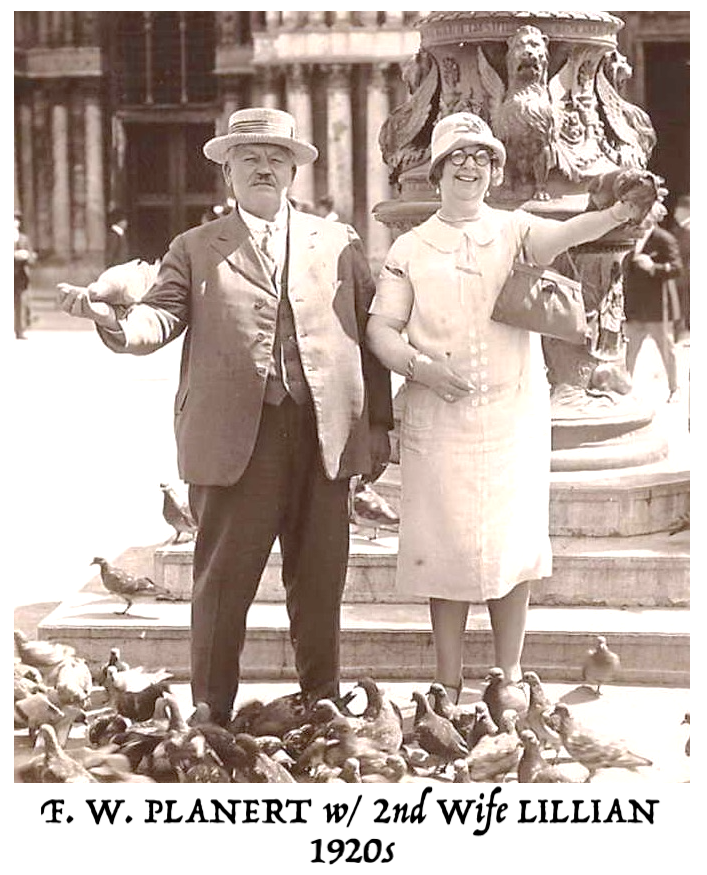 Unfortunately, back in Chicago, all was not smooth skating as the 1930s arrived. Along with competing with other skate manufacturers in product development and innovation, Planert & Sons now faced an economic outlook that saw fewer families willing to budget for pricey hockey and speed skating gear.
Unfortunately, back in Chicago, all was not smooth skating as the 1930s arrived. Along with competing with other skate manufacturers in product development and innovation, Planert & Sons now faced an economic outlook that saw fewer families willing to budget for pricey hockey and speed skating gear.
Merely touting the quality of an ice skate wasn’t going to be enough. To raise the perceived necessity of its goods, Planert would have to use the strategy still preferred by most leading sporting goods companies of the 21st century—they went looking for celebrity endorsements. Or, to put it more accurately, they paid players and teams to help pump up the Planert profile. This included the aforementioned Chicago Blackhawks, an underdog club that enjoyed a timely uptick in success during its Planert affiliation in the mid 1930s. Fan favorites Tommy Cook and Louie Trudel, along with our pal “Mush” March, proudly hit the ice in Planert’s Northlights skates—“because they stand up under the toughest going!”
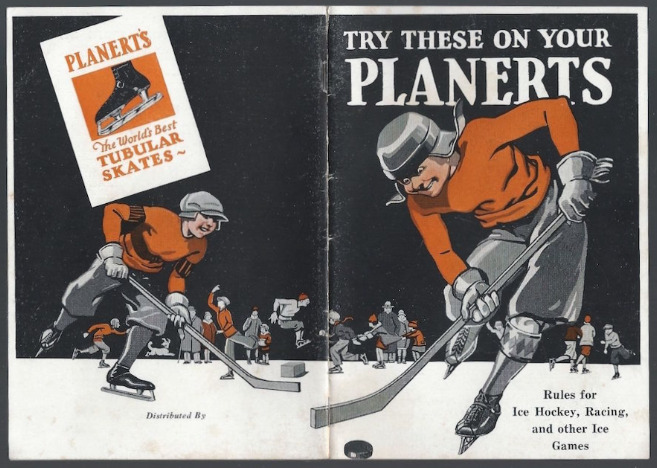
To help bring in addition sales, the family established a second organization, the Planert Tool & MFG Company, run by John Planert from a building at 400 S. Hoyne Avenue. This would eventually evolve into the Planert MFG Corp. (est. 1937), a tool and die manufacturer at 2256 W. Walnut Street, which would become an active defense contractor during World War II.
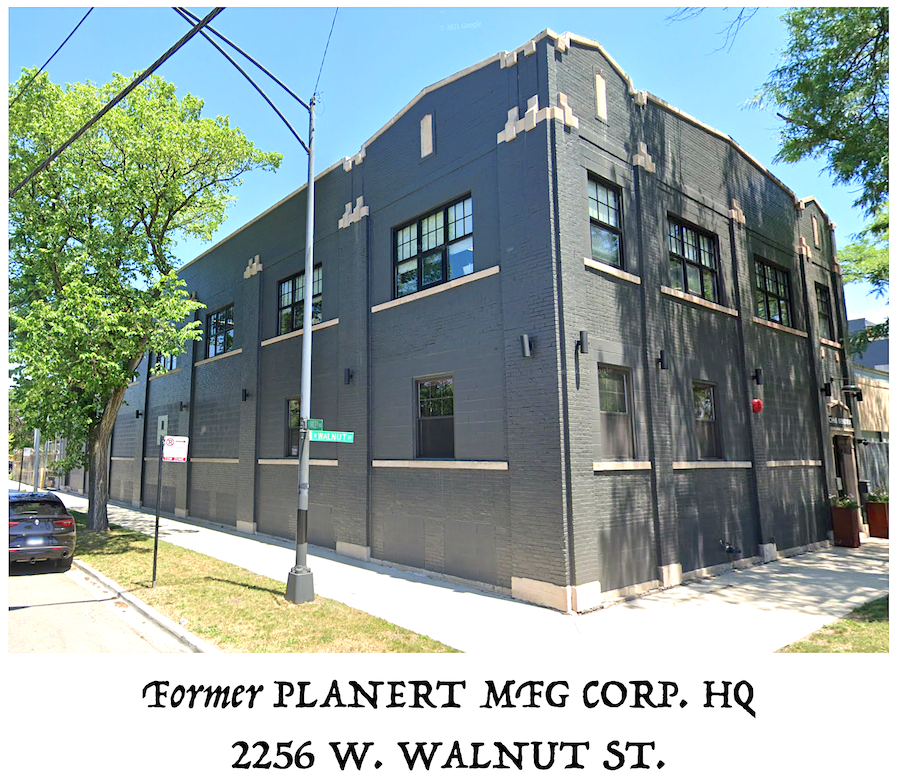 Try as they might to diversify, though, the Planert name was locked into the public consciousness for one thing alone, and it would remain so long after the death of founder Fred Planert in 1936 (aged 78).
Try as they might to diversify, though, the Planert name was locked into the public consciousness for one thing alone, and it would remain so long after the death of founder Fred Planert in 1936 (aged 78).
Re-organizing as the Planert Skate Company, the business remained small but successful, employing about 70 regular workers through the ’40s and ’50s; still based at the Damen Avenue plant, and still making skates, one by one, as they always had. During and after World War II, Charles, Edward and George Planert all remained executives in the business. Each one contributed creatively, as well. Charles earned a patent for a skate strap fastener, Edward for a blade protector and tendon guard, and George for his updated sharpening jig. George Planert also helped revolutionize the racing skate with his work on the “Planert Special,” a high-end, hand-made design that became the choice of many Olympic speed skaters, and remained largely unchanged from the 1930s through the ’50s.
In 1949, Chicago Tribune scribe Jane Gardner wrote a profile on the Big 3 of Chicago ice skate manufacturing for the Sunday paper. By that point, Planert had been going strong for half a century, and its ranks had extended to a third generation, led by the company’s new official “special skate maker” Bob Planert (son of George R.) pictured below on the right.
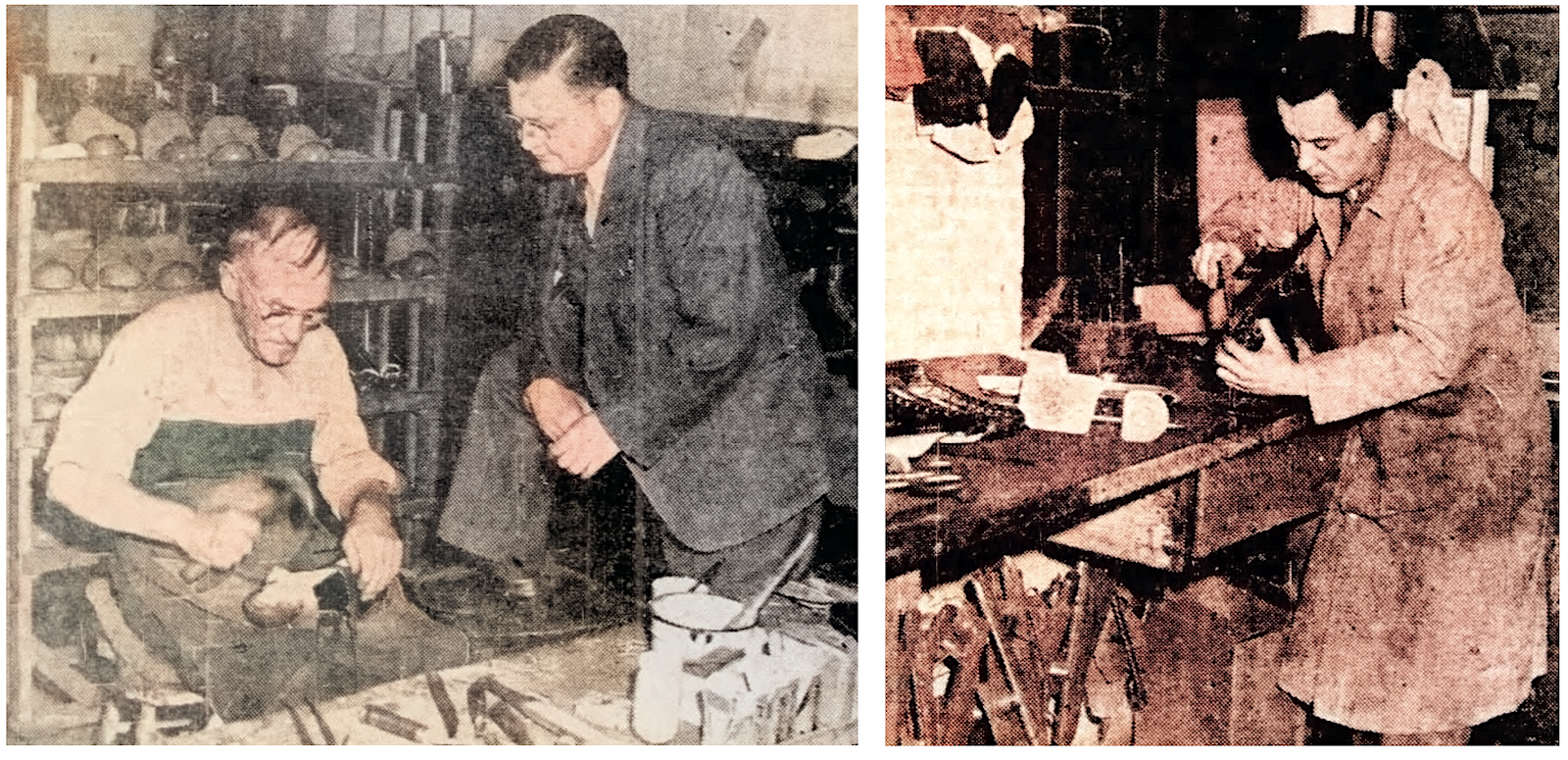
[Inside the Planert Skate Company plant at 935 N. Damen Ave., 1949. Left: Edward Planert watches over shoemaker Joseph Macena as he attaches leather to a custom hockey skate. Right: Third generation executive Bob Planert shows the family still values technical skill on the factory floor, as he is seen here copper riveting a skate blade to a shoe.]
As Bob Planert later recalled in a 1996 interview, construction of Planert’s skates was every bit the painstaking process it looks like in the photos above. “There were quite a few parts involved, and it involved quite a bit of work,” he said. The same article recounts how “the hardened steel blades . . . were designed to withstand rugged use and keep their skating edge. Instead of a ‘squeeze fit,’ the runner was inserted into a semi-hardened tube and holes were drilled every three inches; rivets were placed in the holes and soldered to firmly hold the tube and runner together. . . . The tube was then inserted into the slots on the cups, and then riveted and soldered to the cups; the cups, in turn, were riveted to the heel and the sole plate of the boot. Rivets and solder were also used to attach the front bracket to both the tube and the boot.”
Unsurprisingly, this kind of dedication to craftsmanship wasn’t destined to keep a business profitable as cheaper import skates began entering the market after the war. The Planert Skate Company was put up for sale in the late 1950s, and by 1960, one of its biggest rivals, the Bauer Skate Company of Ontario, purchased the Planert racing division. After the acquisition, the Chicago plant was finally shut down, but the product carried on, as Bob Planert relocated to Kitchener, Ontario, to run Bauer’s speed skate department, leading more innovations in indoor skate design and continuing to oversee production of Planert-branded specialty skates.
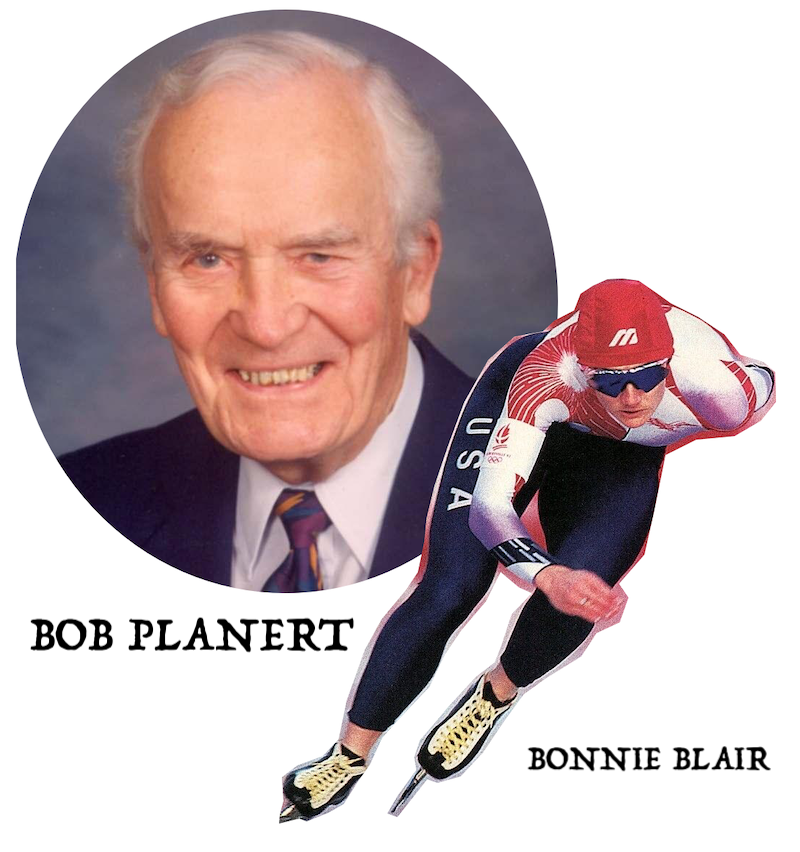 Bauer discontinued its speed skate production in 1978, and Bob Planert went into semi-retirement, though he continued to make Planert Specials for Olympic medal winners, including Eric Heiden and Bonnie Blair. Following his death in 2010, Bob became just the second individual to be elected to the National Speed Skating Hall of Fame in both the U.S. and Canada. He was later remembered by friend and skate historian Jean-Marie Leduc as a “soft-spoken and gentle man” who was “easy to work with. . . . Planert would slave over every detail of each pair of skates to ensure they met the skater’s requirements, and skaters came to love his approach.”
Bauer discontinued its speed skate production in 1978, and Bob Planert went into semi-retirement, though he continued to make Planert Specials for Olympic medal winners, including Eric Heiden and Bonnie Blair. Following his death in 2010, Bob became just the second individual to be elected to the National Speed Skating Hall of Fame in both the U.S. and Canada. He was later remembered by friend and skate historian Jean-Marie Leduc as a “soft-spoken and gentle man” who was “easy to work with. . . . Planert would slave over every detail of each pair of skates to ensure they met the skater’s requirements, and skaters came to love his approach.”
Bob wasn’t the only Planert to remain relevant in ice skating circles for years to come. Fred Planert’s son Edward, for example, had a son of his own, Edward Jr.—born in 1926. When Edward Jr. died in 2016, aged 90, he was remembered by many in suburban Chicago for his years of work running a local skating rink and working as an instructor. I guess you could say that if the planets revolve around the sun, the Planerts revolve around the ice rink. . . .
. . . The Made In Chicago Museum would like to apologize to the Planert family for every use of a bad pun in this article.
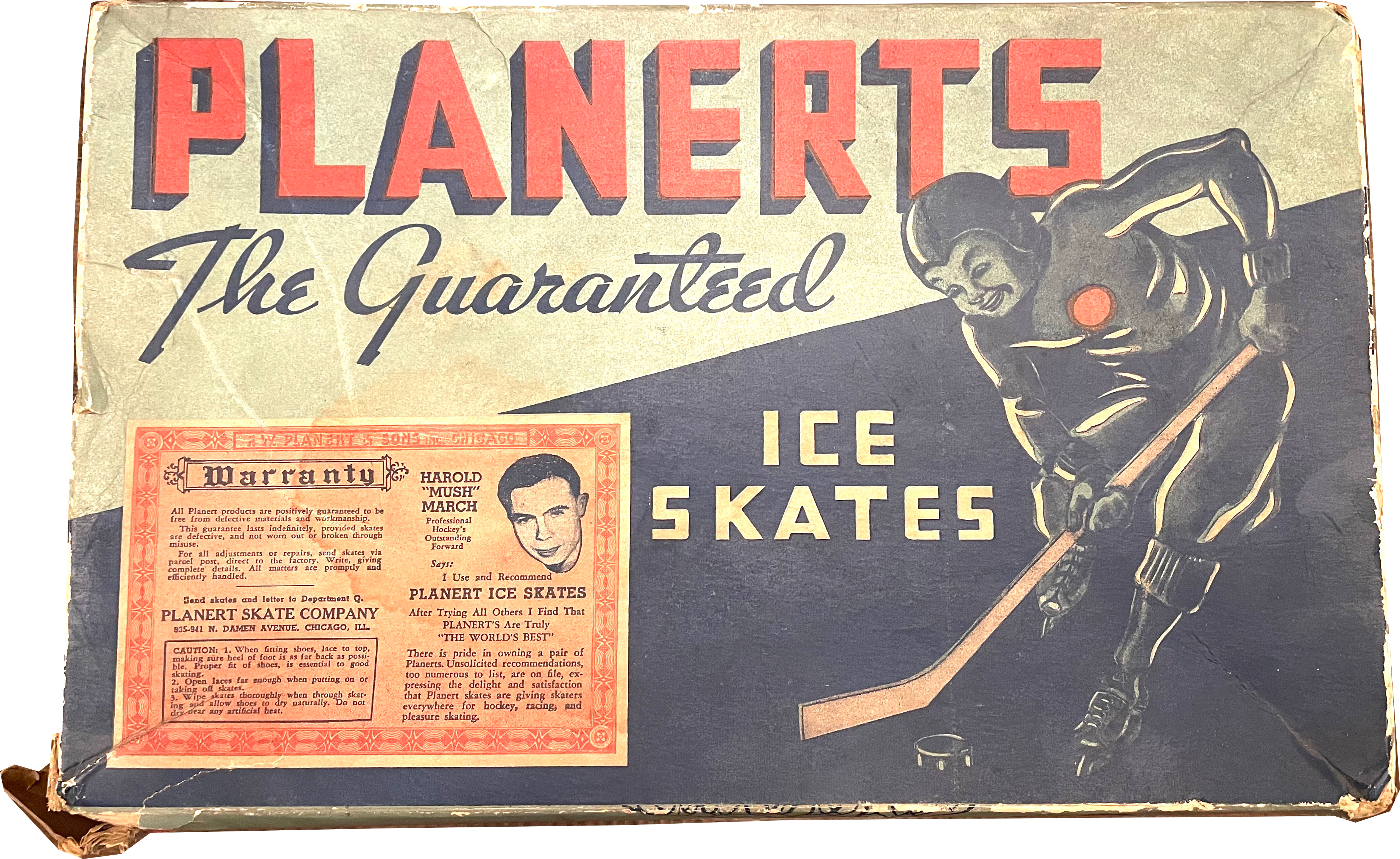

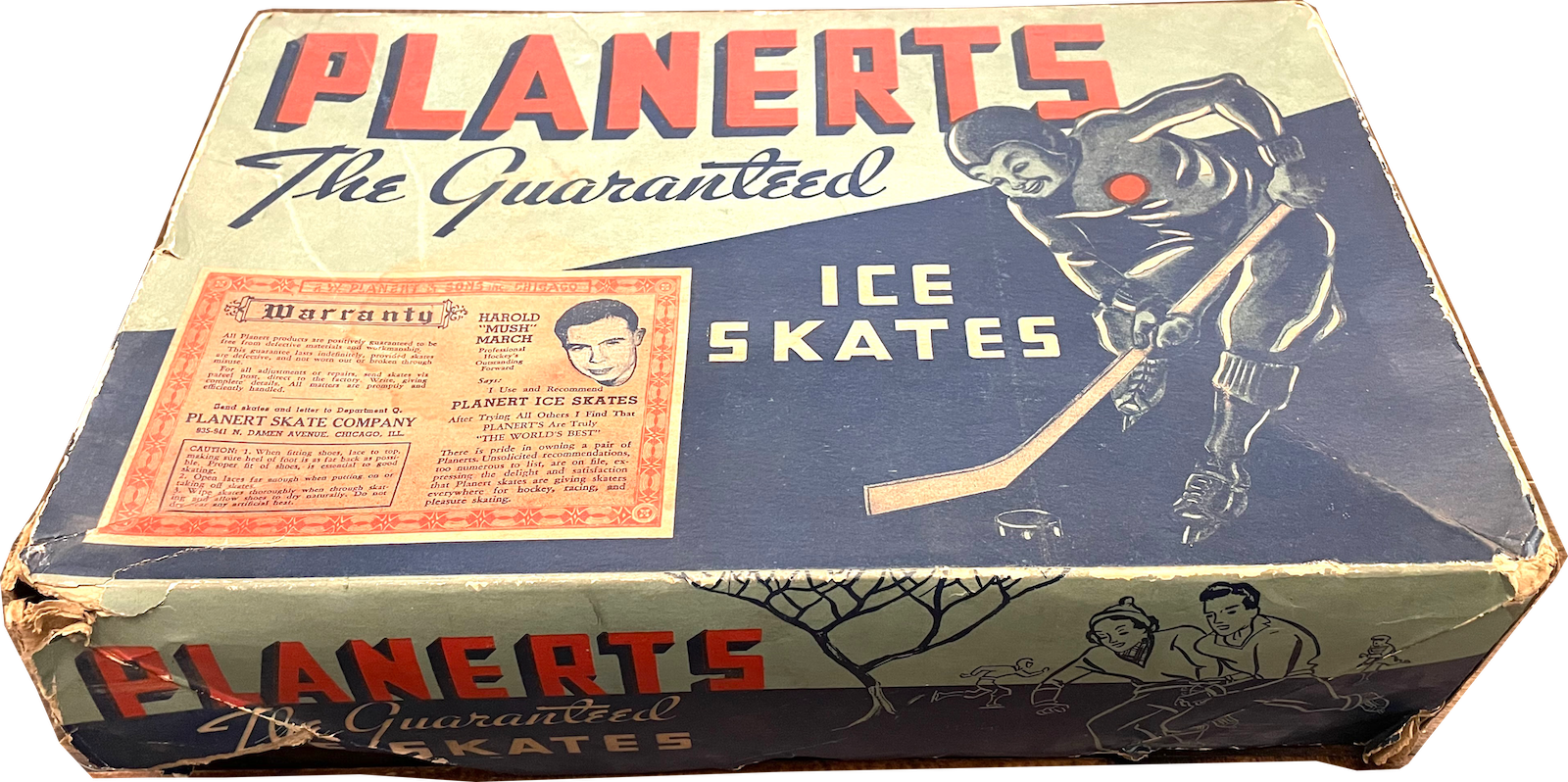
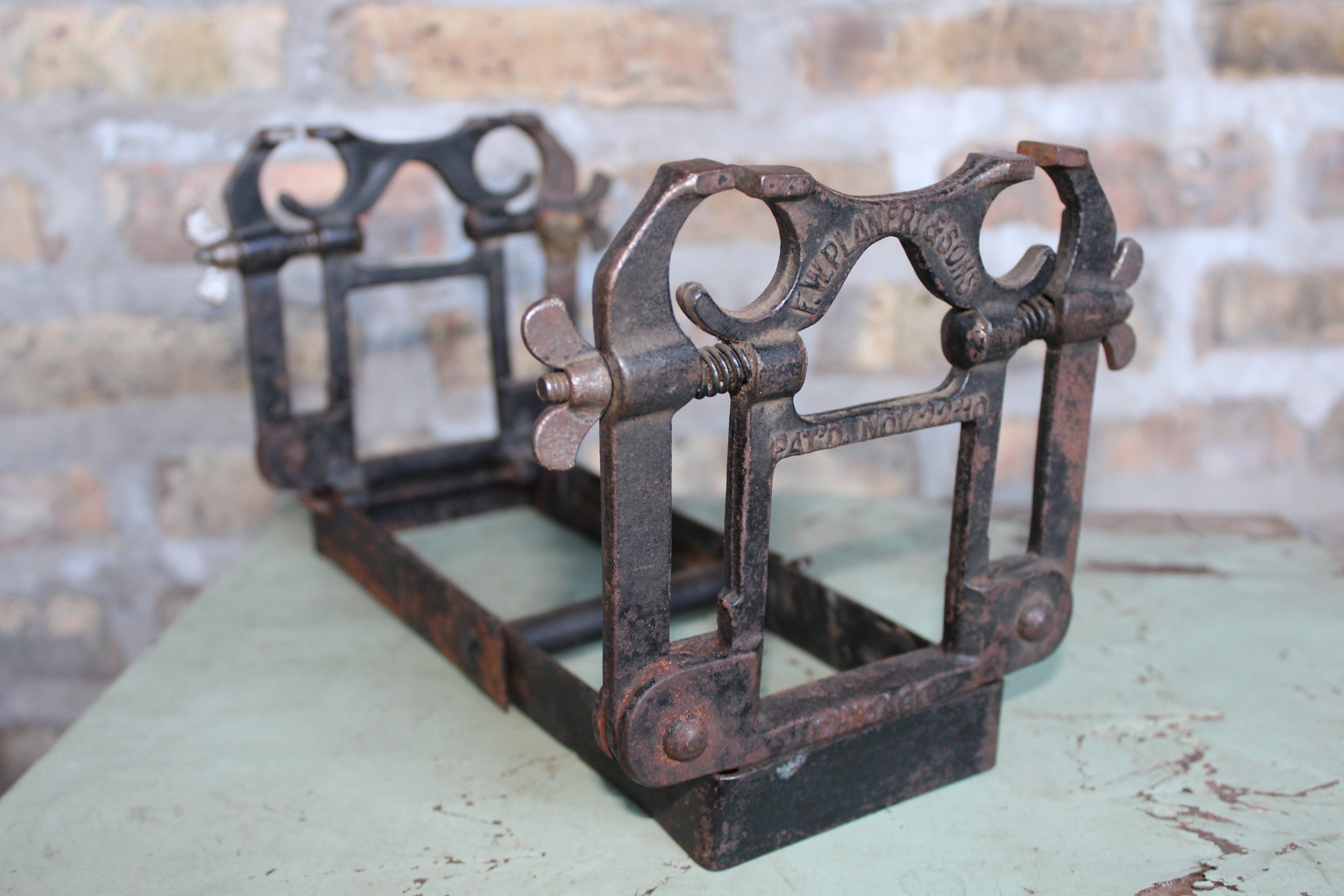
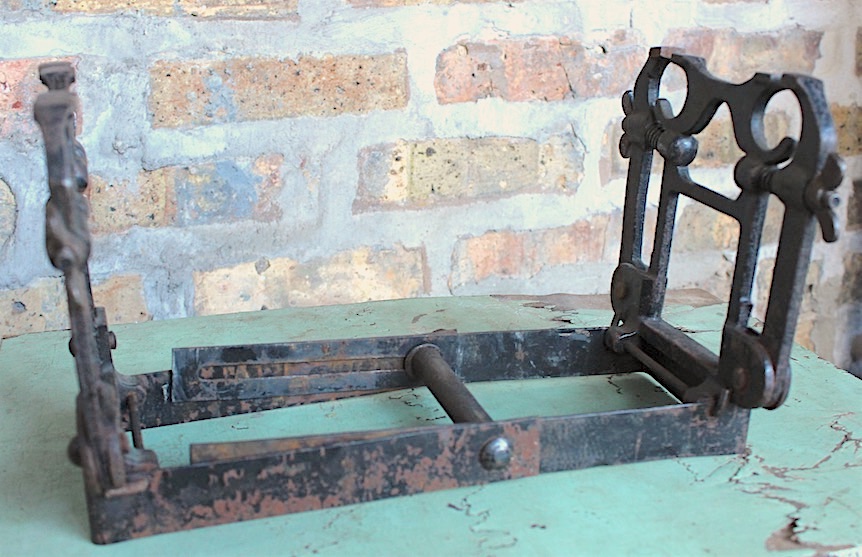
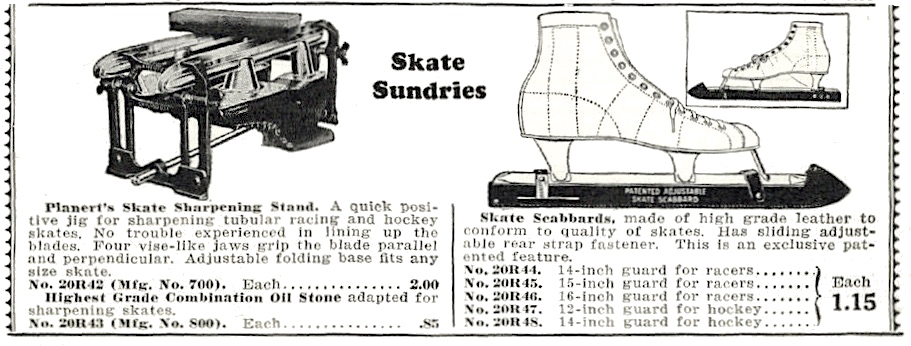
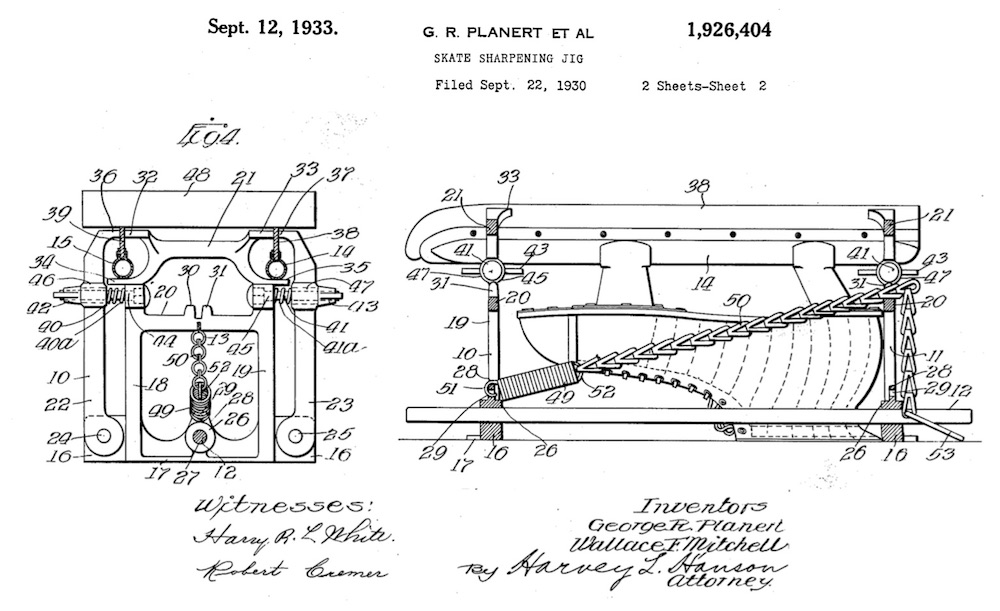
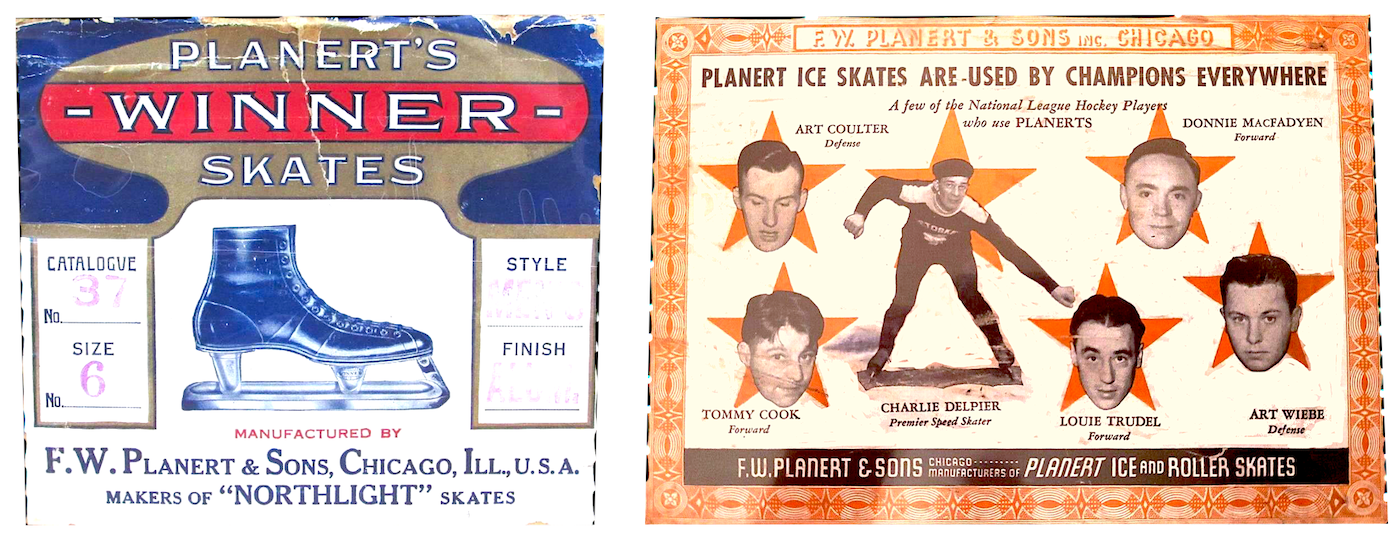
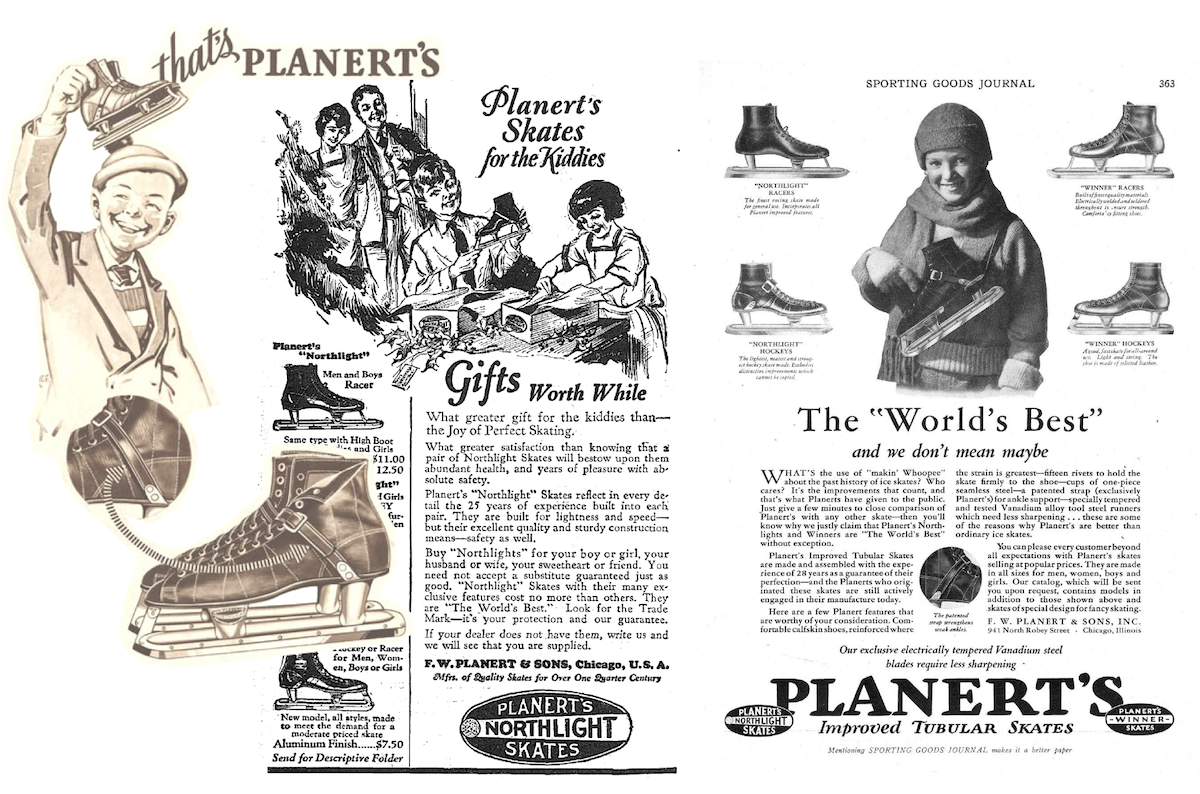
Sources:
“Ice Speed Marvels Meet at Douglas Park Today” – The Inter Ocean, Feb 9, 1913
“The Story of Tubular Ice Skates” – Hardware Dealers Magazine, November 1926
Technological Advancements in Sporting Equipment For Selected Sports, Prepared for the Saskatchewan Hall of Fame and Museum and Sask Sport Inc., by Deanna Christensen, 1996
Lace Up: A History of Skates in Canada, by Jean-Marie Leduc, Sean Graham, & Julie Leger
“Speedskating Club Founder Inducted into U.S. Hall of Fame” – The Record, June 4, 2014
Archived Reader Comments:
“So excited to see all this. I am the great, great granddaughter of Fred Planert. It’s not surprise that I love to skate! Loved this history, thank you! ” —Debra, 2020
” —Debra, 2020
“This is my great great great grandfather!” —Matt Christian, 2019
“We lived in Glen Ellyn, IL, for nine years while our children were growing up (1970 -79). They both took lessons at Planert’s on Park Blvd., Paul for hockey and Gail for figure skating. Planert’s was an integral part of their growing-up years. It was a wonderful, wholesome atmosphere. Both kids, now in their mid 50’s, still skate. Paul has never quit being a goalie (he’s on a couple of teams), and Gail has continued her interest, also.  ” —Marge des Lauriers, 2019
” —Marge des Lauriers, 2019
“Great grandson Gregg Planert is still a prominent speed skating coach in Canada!”–Lars Lehmann, 2017
“I recently bought a pair of Planerts ice skates from a antique shop in Los Angeles California. They are in the original box and I don’t think they have ever been worn. Inside one of the skates there is a second pare of laces and wax still on the rivets. I appreciate the history you shared, it makes these skates so much more special. Thanks ” —Tina, 2017
” —Tina, 2017
“Wow! Great summary of the company’s history! Fred Planert also owned the apartment building next to the factory. It is still there. In the 1950’s the company was sold to Bauer in Canada. Bob Planert moved to Canada to run the new Planert division. Bob left quite a legacy in the Canadian speed skating world, ending in his induction into the National Speedskating Museum and Hall of Fame.” —Susan Planert, 2016

I had two pairs of planner speed skates one size 6 one size 11 and I worked at the Bluejay ice rink in 1978 and I used to go
Out on the eyes during the middle of the session with a squeegee and my speed skates and get the water puddles off while everyone waited, and I also skated out on big Bear Lake when it rows over in the Sandino mountains
Went online today to see if there was a location to which I might send an old pair of Planerts….given to me by my brother in the 1940’s. My brother, Edgar J. Dame was inducted into the Speed Skating Hall of Fame having won just about every skating meet he entered in those days. In the prior interesting comments by skaters, I did not see any from the Boston area, though there were many, many wonderful skaters from here….all of whom, I’m sure wore Planerts. Thanks to whomever started this site. Very interesting to those of us who remember the races of so many years ago
Do you ever receive old skates or skate sharpener for your museum?
Eileen
Back in the early sixties, when I was 5 or 6 I got my first pair of planert speed skates. I remember that they had red stitching on black leather. They looked so cool. I loved them and wish I still had them.
I came across this web site and really appreciate the work of putting it all together. I worked for Ed Planert at his skating school. It was named Glen Ellyn Ice Skating School. I worked for Mr. Planert in the early 1970’s. He literally taught me quite a lot about the business. He was a great person to work for. In time I had a key to the door and would work hours that he was not able to be there doing everything from sharpening skates for customers to teaching lessons to selling skates to resurfacing the ice with a 55 gallon drum on wheels that would put down water for a new sheet of ice on the rink. We, being all of the employees, had a great time working there in that little ole ice rink. Again, Many Thanks. Dennis Heiner
I have a pair of white child’s planert figure skates that my older brother bought for me in the early 1950’s. Barely used. Wondering what they are worth and what he paid for them then. Does anyone have a 1950’s Planert catalog?
I skated for Pierce Club in the 60’s with Joey and Jim Nakao and many other great skaters.
I later skated for Northbrook Club coached by Chuk Burke and had Johnson and Planert “California Radicals” as they were called for extreme offset for short-track. My son skates in Utah at the OTC. Great memories and sport.
Brian Jonland, Mark Elliott, Richard Ring.
Skate until you drop. The Peirce club lives on. Bryn Mawr avenue chicago.
jim nakao Peirce skating club, Chicago.
I remember in the 1960,s through the 70s in Binghamton, NY, all the kids were introduced to speed skating through a Plantert’s dealer working out of his basement. Harold G Beam who once was an Olympic speed skater (as I believe his son was) that assured that all children could have skates. His passion and charity contributed to several skating parks full of speed skating kids on our west side. Even intramural hockey team members played in them those days. Dozens of kids were given chances to buy used and newer upgraded models. Loved the kangaroo boots now that most have gone synthetic.
In the 1950s I skated for the Peirce Skating Club in Chicago. I believe that I got my first pair of Planert speed skates about 1947. I remember going to the shop on Damen Ave. many times as I grew up. And I still have several pairs of Planert skates and a sharpening jig, although I have not skated now for many years. I have fond memories of skating in Illinois and in the national championships in Saint Paul and at Champain-Urbana. There is not much ice in Lawrence, KS where I have lived for the last 43 years.
Rich Ring
I was a Detroit-based speedskater from 1963 to 1978. I won multiple national and state championships and set several national and state records on my beloved Planert “outdoor” and “indoor” skates. As I outgrew skates rapidly, we (many Detroit skating families: the Brennans, the Youngs, etc.) made multiple Summer trips to Kitchner, Ontario, where Bob would trace our feet and ship our custom blades in October. To us Bob was a soft-spoken, super-encouraging hero! Decades later, I can say that few things have served me so ably as my Planert speed skates did… Fun names below! I skated with Dick Somalski’s boy Jerry and Terry McDermott was a mentor…Jim Chapin’s boy Jim Jr. could FLY and so could Gary Jonland! Leah Poulos and her brother Sam were dear friends. I have a group picture from a national championships with all of these people and more, including New York Met Lee Mazilli!
I skated in Bay City, MI from 1959 (10) to 1965 (16). We were coached by Dick Somalski (Essexville, MI) nursery and landscape business owner by day and Olympic Champion Coach in season. Everyone on the team (in all of MI) competed on Planert ‘Specials’. In Bay City we ordered custom Planert Specials from Dick. He traced the outline of each foot, took measurements and ordered them from Planet. Petoskey, MI hosted the National Championship in about 1964. Everyone competing on the National level glided on Planert outdoor and indoor short track skates. Indoor track design formed a parallelogram, maybe 1980s the shape changed to oval. The Outdoor track for Olympic training was a 400 meter, large enough few local ice rinks had the space. If the space was available it would preclude the public recreation ice skating space. No one wanted to interfere with recreational skating. That’s how most first family skaters started. Eliminate or reduce public skating and you hinder developing future speed skaters. Olympians from MI I knew were Jeanne Omalenchuck, Cathy Sullivan and Terry McDermott. Terry was Dick Somalski’s nephew. Terry, following his Gold Medal and World Record at 500M appeared on the Ed Sullivan show same night as the Beetles. Terry was a Barber so the Beetles posed with Terry for a picture of Terry simulating cutting the Beetles hair. Dick Somakski especially, and all the parents who drove all over MI with cars full of kids and skates were Saints, God Bless them all and the families that supported them.
i have a pair offset size 9 made last production in Canada late 50’s. I bought them 1959. 95%. no rust. leather still smells like leather. john
I mistakenly gave away my Planert Intermediate Offset speed skates probably 20 years ago. Wish I could have them back. I don’t think I could skate now as I have bum knees and when I even thing about skating my feet start to hurt. But in 1972 I won the Silver Skates at Winterhurst in Lakewood Ohio. Such a fun and exciting time. I would love to try to skate again, but apparently they don’t make speed skates anymore.
A tremendous article on the Planert history. I stated skating when I was 5 and racing at 14. I began on a pair of Alfred Johnsen stock racing skates but the Planert Olympic model was “the Cadillac” of racing skates the 40’s and beyond. My first Planert’s cost $150.00 in 1950 then and I still have them but have not used them for a long time. That is equal to $1,600.00 today.
My grandfather took me to the Planeert factory on N. Damen Ave. an I met Bob Planert where we had a longtime friendship. Everyone used Planert’s. High quality kangaroo leather steel construction. After Bauer bought Planert Bob had to squeeze in speed skates manufacture because hockey skates were Bauer’s specialty and income producer.
Thank you for this interesting article! I am a Planert and I am sure we are related somehow to the founder. It is neat to learn about family history!
I only had one pair of planet specials that replaced my planner north lights.
I was born in 1945, and I had an older sister, five years older than me, who got everything, new bicycles, ice, skates, clothing, etc. I had no choice and had to take my hand-me-downs from Pat. So after my first pair of double runner skates. proved a waste of time, my first ice skates were white girls, figure skates with little pom-poms on front…
After quite a few torn shirts, and bloody noses from fighting with the other boys, who made fun of me, I cut the Pom-poms off and took black shoe polish, and tried to make my figure skates with the little jagged edge on the front look more “masculine”…
But when I saw the big boys gliding around the skating rink, at “Touhy” (TouhyAvenue and the Lake, as one of Sam Leone!s Boys-… I had to get a cheap pair of Nestor Johnson’s, and started saving up my money to buy my first pair of Planerts Northlights snd then my only pair of specials.
I kept reading the above article, waiting to find out about whether or not, I had made up in my head the story of my planets being made of thin, supple, kangaroo leather, with no ankle support whatsoever, fitting on my foot likeOJ Simpson’sdriving gloves.
I skated, round and round and round at the rink at Touhy Avenue and the lake, every day, every night.
I did lots of other sports and one competitions in gymnastics wrestling track swimming,,, but it was an ice-skating, speed skating, that I know I could’ve been an Olympic medalist.
Helen Lutsch from Pierre skating club kept trying to recruit me, and it was tempting to see all those fancy uniforms and equipment and warm-up pants that zipped up the side and I was just a Chicago kid in blue jeans and long underwear, but I never met anyone one on one that I couldn’t beat at the under 1 mile distances…
Somewhere, I still have my planet specials with a small section, eaten away by mice, and the flat bottom plates worn away on one side I’m going around the turns on such a
Flat angle.
I used to sneak Out of our apartment on Sherwin Avenue or maybe it was when we moved to Green leaf, late at night and try not to let the Chicago cops on their little three wheeler Motorcycles see me as they patrolled Sheridan Road in Rogers Park.
I just couldn’t stay away. I was addicted so that late at night if they weren’t out flooding with the fire hose to add more ice for the next morning, and everything was dark and black,
I would sneak behind Nikki’s refreshment stand at the circle at the foot of Touhy Avenue
And takeoff my shoes and put on my skates And find the edge of the concrete wall by the ramp by feel , so they’re in the complete darkness of a cloudy starless night I would picture in my mind, the perimeter of the rink and then from memory, I would feel that absolute freedom and exhilaration of hurtling, through complete darkness, unable to see anything, except in my minds eye feeling my only connection to anything other than cold and dark and dizzying speed in that line of force, going down to the bottom of my foot, connected to the steel plate and the steel blade and that tiny sharp edge of melted ice.
For an hour I stopped being afraid of crashing into the wall or slipping, or hitting a snowbank, and I became disconnected and unanchored from everything and everyone in the world. for a time I could be perfectly happy, no thoughts of technique no thoughts of pain, no thoughts of being anything, except perfectly at one with the wind and the darkness. I had to get a job to earn money to go to college, so I never got to test myself against the Olympics, but I could cry, now, just thinking about what I’m sure only other addicted athletes ever get to experience, when you are no longer thinking about technique and suddenly it’s effortless, And you are no longer struggling against pain or tiredness or ice for wind you have become them. All that on my Planert specials. in complete darkness in my blue jeans and long underwear, wearing out the bottom plate on my planner specials… For me better than any gold medal…
.
what a remarkable story and vidid memory. Thanks so much for sharing! ps. They almost certainly WERE kangaroo leather! –Made In Chicago Museum
I have a pair of Planert Pro ice hockey skates, with a snap on tendon guard. My father bought them at ZWICKERS, 19 Mill Street, Arlington Ma. Circa ,early 1960’s.
My brother’s & I were all speed skaters and wore Planert speed skates. Gary Jonland (2nd oldest brother) was in the 72 Olympics. My grandfather (John Burke) was a coach for the CYO skate club & my uncle (Chuck Burke) was in the 52 & 56 Olympics. Chuck coached the Northbrook speed skating club for many years and is still involved in the sport at the age of 90. All were big proponents of Planert skates and knew the family well.
Gary still has a pair of Planert’s and skates on a frozen lake in Port Townsend, Wa.
Great Chicago company & history!
I am sitting in front of this computer with my Planert speed skates that are in near perfect condition being the second pair I bought as an adult and never used. Got too old? This article brought back memories of the popularity of speed skating in the town I grew up in, Northbrook, Illinois. I had the pleasure of going to school with the speed skating Olympians Leah Poulos and Diane Holum. It was here that Ed Rudolph skater and cyclist helped put Northbrook on the map as a speed skating and cycling center. The velodrome in town is named for him and it was turned into an ice rink in the winter. I was out skating the night the Beatles appeared on Ed Sullivan and we watched it from the warming house. Fun times!
Do you want to sell them
Hello. My oldest sister just gave me a pair of men’s skates. Which her late husband used as a teen. Planert’s speed skating skates. They look great in their condition. Black in color. No show laces. I would like to know their worth. I don’t need money, just i want to know their worth. I also would like to know, if Fred Planert’s grand daughter would like to have this skates. If not, i will donate them to chicago museum.
I am Ed Planerts grandson ,was speed skater in the late 50s and early 60s in the Chicago land area. My Xmas present every year was a new pair of speed skates. Both of my younger brothers played hockey on Planert skates. I still have blade trophys from the Chicago Tribune Silver skates. What a great family to a part of.